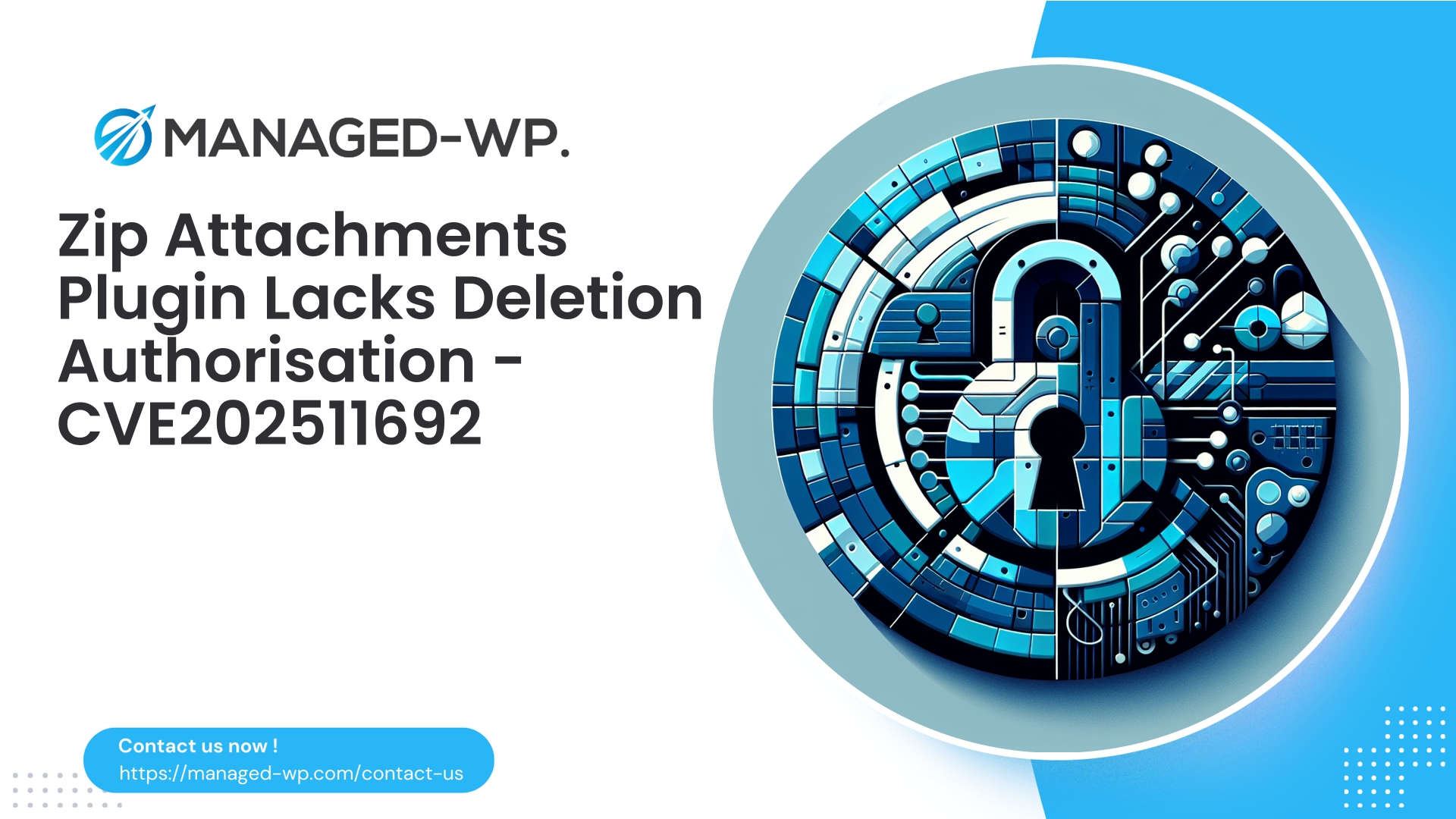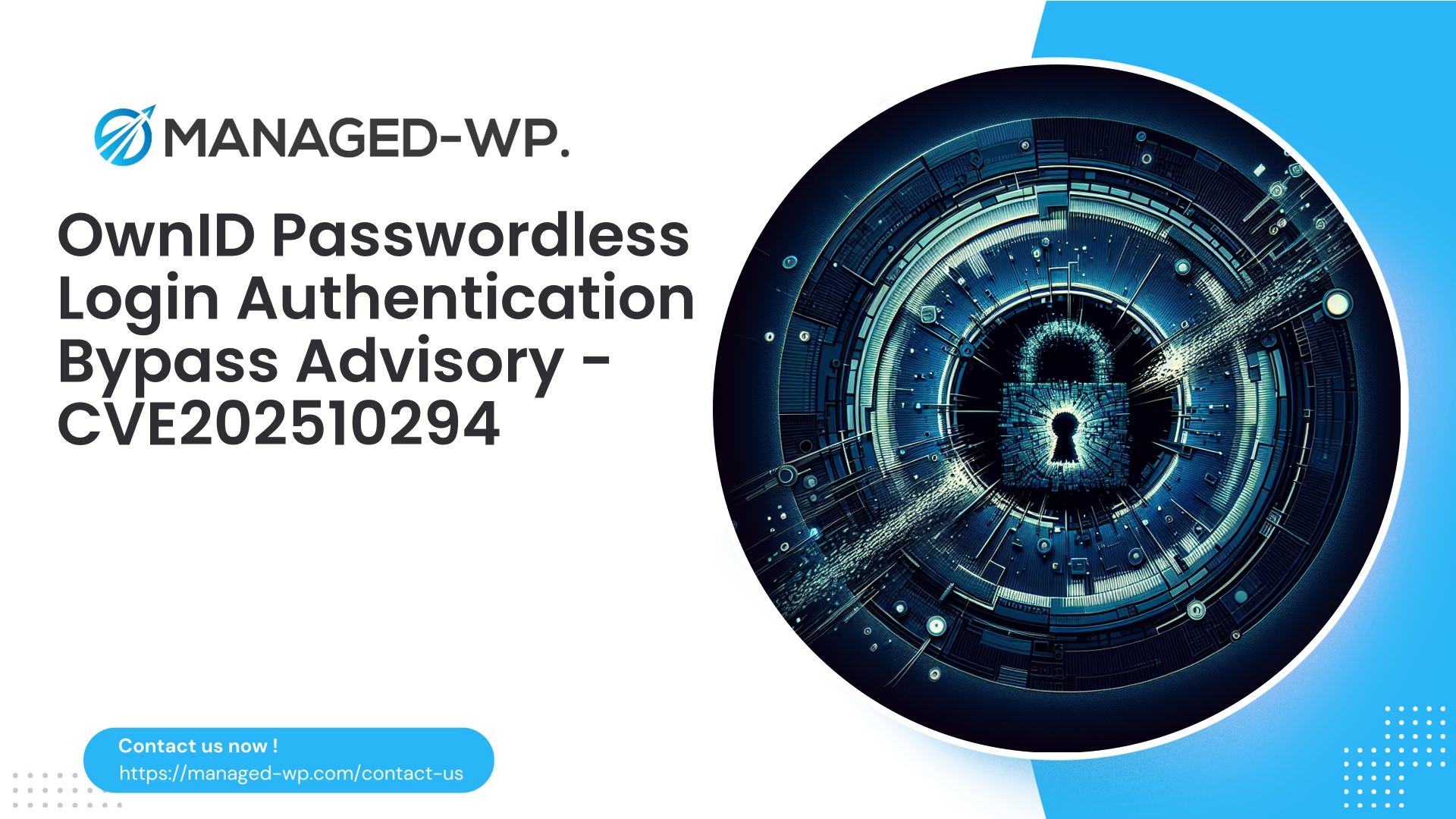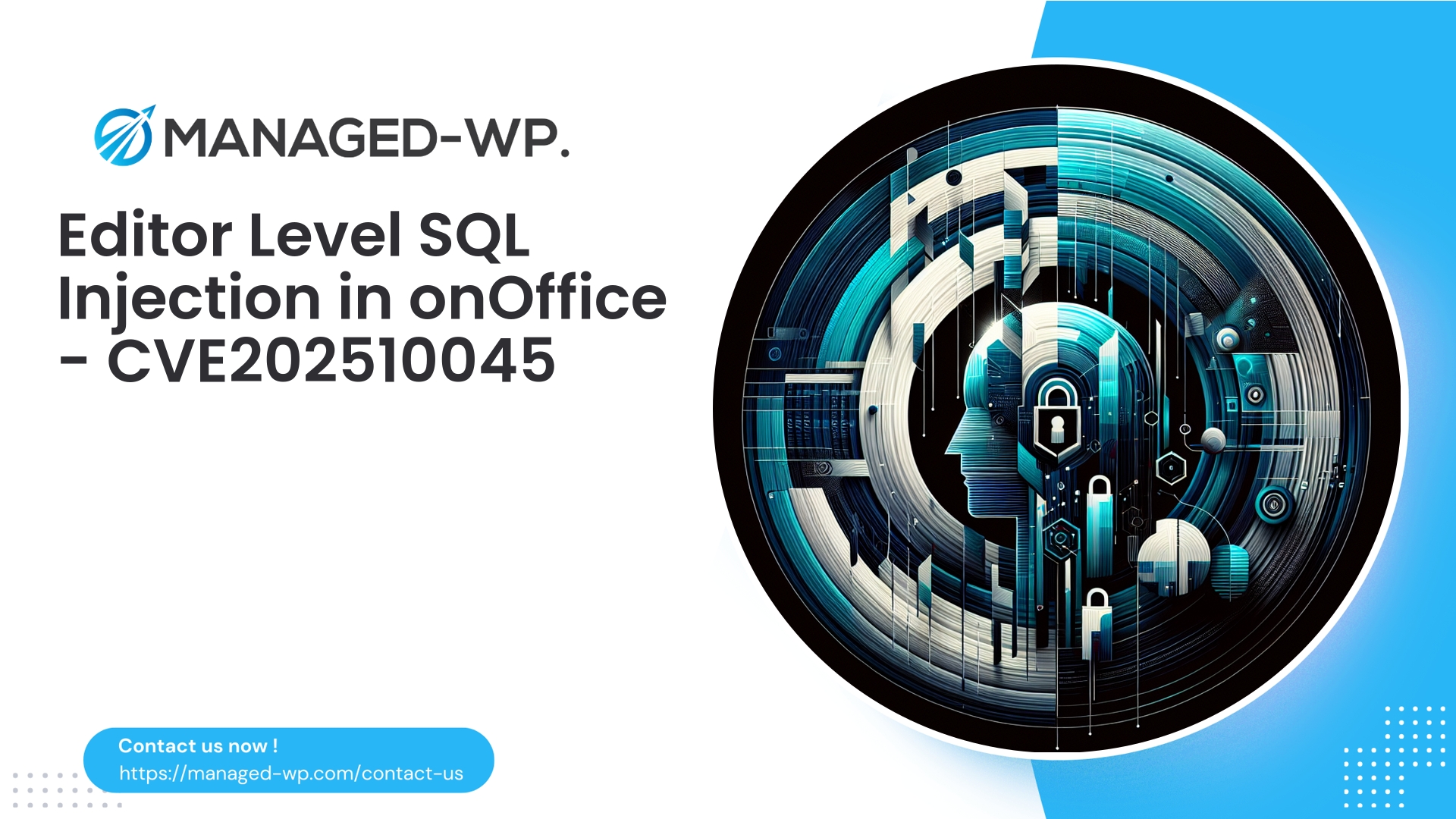| 插件名稱 | 拉鍊附件 |
|---|---|
| 漏洞類型 | 繞過授權 |
| CVE編號 | CVE-2025-11692 |
| 緊急 | 低的 |
| CVE 發布日期 | 2025-10-15 |
| 來源網址 | CVE-2025-11692 |
Zip 附件 <= 1.6 (CVE-2025-11692):來自 Managed-WP 安全專家的 WordPress 網站所有者重要指南
日期: 2025-10-15
作者: 託管 WordPress 安全團隊
標籤: WordPress、漏洞、安全性、CVE-2025-11692、託管 WordPress
執行摘要: WordPress 外掛程式「Zip Attachments」(1.6 及以下版本)中發現的存取控制漏洞已被公開揭露,漏洞編號為 CVE-2025-11692。該漏洞允許未經身份驗證的攻擊者利用插件管理的檔案進行有限的檔案刪除操作。儘管 CVSS 評分將其嚴重程度評為中低(5.3),但它仍然會帶來實際風險,包括資料遺失、服務中斷,並可能成為進一步攻擊的跳板。本分析清楚地概述了該漏洞、風險評估、即時緩解策略、長期解決方案,以及 Managed-WP 的安全服務如何幫助您有效保護 WordPress 環境。
目錄
- 概述:披露詳情
- 技術概述及漏洞性質
- 潛在攻擊場景及業務影響
- 風險評估:哪些人容易受傷?
- 檢測策略和監測指標
- 立即緩解的緊急應變措施
- 長期修復和加強最佳實踐
- 虛擬修補程式和託管WAF的優勢
- 辯護規則範例及其理由
- 受損網站的事件回應工作流程
- 託管式 WordPress 保護方案及入門指南
- 總結建議和資源
概述:披露詳情
2025 年 10 月 15 日,WordPress 外掛程式「Zip Attachments」的一個安全漏洞被揭露,具體影響版本為 1.6 及更早版本。該漏洞被歸類為存取控制失效(一種授權繞過機制),允許未經身份驗證的使用者觸發插件管理的檔案的刪除。
要點概覽:
- 受影響的軟體:Zip Attachments WordPress 插件
- 受影響版本:1.6 及更早版本
- 漏洞類型:授權繞過(存取控制失效)
- 利用該漏洞無需身份驗證(任何訪客均可利用)。
- 已分配的 CVE 編號:CVE-2025-11692
- 報告日期:2025年10月15日
- CVSS評分:5.3(中/低)
- 官方修復狀態:揭露時尚無廠商補丁可用
這意味著未經授權的攻擊者可以向插件的刪除端點發送請求,以刪除它管理的某些文件,這可能會影響網站內容的完整性和可用性。
技術概述及漏洞性質
存取控制漏洞是指關鍵功能在未驗證使用者權限的情況下執行。在本例中,Zip Attachments 外掛程式暴露的檔案刪除功能缺乏足夠的授權檢查。
- 此漏洞利用未經驗證的 HTTP 請求插入 AJAX 或 REST API 端點。
- 該插件僅刪除插件管理的檔案(範圍有限),不會刪除任意伺服器檔案。
- 觸發刪除例程不需要身份驗證令牌、隨機數或功能檢查。
重要提示:
- 沒有跡象表明這會導致遠端程式碼執行或資料外洩。
- 主要影響是透過刪除插件資源來拒絕服務。
- 由於缺乏身份驗證要求,自動化攻擊構成實際威脅。
潛在攻擊場景及業務影響
了解攻擊路徑有助於確定緩解措施的優先順序:
-
內容刪除和拒絕服務攻擊:
- 攻擊者可以刪除下載過程中至關重要的壓縮附件,從而破壞功能並影響使用者體驗。
-
關鍵營運期間的業務中斷:
- 依賴動態產生的壓縮檔案進行商務或會員服務的網站可能會失去重要資產,進而影響收入。
-
偵察和進一步利用:
- 刪除檔案可能會掩蓋惡意活動或為二次攻擊做好準備。
-
名譽損害:
- 內容反覆遺失會損害用戶信任,並可能需要付出高昂的補救和溝通成本。
雖然保密風險有限,但資料可用性和完整性卻受到損害,而這正是至關重要的安全目標。
風險評估:哪些人容易受傷?
並非所有 WordPress 網站都會受到影響——請考慮以下幾點:
- 未安裝 Zip Attachments 外掛: 此 CVE 無需採取任何行動,但一般的網站安全最佳實踐仍然至關重要。
- Zip Attachments ≤ 1.6 已安裝並啟動: 立即採取高度優先的緩解措施。
- 插件已安裝但已停用: 風險較低,但徹底刪除是最安全的,因為不活躍的程式碼仍然可能存在漏洞。
- 未知插件版本: 立即核實以評估暴露情況。
優先排序建議:
- 處理數位商品、會員內容或重要上傳內容的網站應立即解決此問題。
- 對正常運作時間有要求的電子商務、金融和會員網站是優先考慮的對象。
- 流量較低的網站或測試網站仍然需要關注,但可以在備份和隔離之後進行。
筆記: 完善的備份和復原流程可大幅降低檔案刪除漏洞帶來的風險。
檢測策略和監測指標
早期發現可以減少損失。關鍵監測點包括:
待查看的日誌:
- 針對插件刪除端點、admin-ajax.php 或 REST 路由的意外 POST 或 GET 請求。
- 未經身份驗證的請求,包含可疑參數或來自未知 IP 位址。
- 模式顯示,暴力破解或掃描嘗試後刪除成功。
文件系統和應用程式指標:
- wp-content/uploads 或插件儲存中出現無法解釋的檔案遺失。
- 顯示未經管理員操作的刪除操作的時間戳記。
- 之前有效的附件連結出現 404 錯誤。
用戶和分析指標:
- 關於下載缺失的投訴。
- 下載次數或檔案可用性突然下降。
建議立即採取的檢測措施:
- 啟用並審核 Web 伺服器、WordPress 和應用程式日誌,以發現可疑的外掛相關活動。
- 搜尋日誌中關鍵字,例如「zip」、「刪除」和插件別名。
- 實施文件完整性監控,以便在發生意外刪除時發出警報。
- 使用針對可疑請求模式進行調整的 WAF 警報(請參閱下方的範例規則)。
立即緩解的緊急應變措施
如果您正在使用存在漏洞的版本且沒有官方修補程式可用,請迅速採取行動:
- 立即進行完整備份: 包含文件和資料庫。將備份儲存在異地。
- 停用 Zip Attachments 外掛: 使用 WordPress 管理後台或透過 SFTP 重新命名外掛程式資料夾。
- 非必要程序請卸載: 從伺服器上徹底刪除插件檔案。
- 阻止外掛端點: 實作伺服器或 WAF 規則,拒絕未經驗證的使用者存取插件 AJAX/REST API。
- 加強檔案權限: 確保上傳檔案和外掛程式目錄具有安全的所有權(目錄通常為 755,檔案通常為 644)。
- 驗證備份完整性: 執行測試恢復。
- 加強監測: 保留日誌,注意異常狀況。
- 使用虛擬補丁服務: 託管型 WordPress 客戶應要求自訂的 WAF 規則以阻止漏洞利用模式。
在找到永久解決方案之前,這些措施將降低眼前的風險。
長期修復和加強最佳實踐
遏止疫情後,實施持久安全措施:
- 立即應用廠商補丁: 在生產環境部署之前,先在測試環境中測試修補程式。
- 強制執行最小權限原則: 插件必須驗證使用者權限,並對敏感操作使用隨機數。
- 減少攻擊面: 移除不必要或未使用的插件。
- 自動監控文件完整性: 檢測關鍵文件是否被篡改。
- 定期備份: 安排自動備份並定期進行復原演練。
- 遵循安全開發實務: 對輸入進行清理,驗證權限,並儘量減少對檔案系統的直接存取。
- 部署虛擬修補程式/WAF: 使用WAF(Web應用防火牆)即使在修補程式發布之前也能阻止已知的漏洞利用嘗試。
- 在測試環境中進行更新: 在生產部署前驗證變更,以防止中斷。
- 保持 WordPress 核心程式和外掛程式更新至最新版本: 縮短漏洞暴露視窗期。
虛擬修補程式和託管 WordPress WAF 的優勢
虛擬補丁可以有效地阻止HTTP層面的攻擊:
- 監控並阻止針對外掛端點的惡意請求模式。
- 根據上下文強制執行身份驗證和 nonce 檢查。
- 透過速率限制來限制自動掃描和暴力破解嘗試。
- 即使沒有廠商提供的補丁,也能對新揭露的漏洞做出集中快速反應。
優勢:
- 無需修改插件程式碼即可立即降低風險。
- 營運中斷極小。
- 規則經過調整,避免對合法流量造成負面影響。
局限性:
- 虛擬補丁是臨時緩解措施,不能取代應用官方廠商更新。
防禦型WAF規則及原理範例(非剝削性)
以下是一些WAF概念規則,您的安全團隊或服務提供者可以採用這些規則來降低風險:
- 封鎖未經身份驗證的刪除請求:
必須先驗證 WordPress 登入使用者的 cookie 和 nonce 是否有效,才能允許使用「delete」、「remove」或「file_id」等檔案刪除參數。拒絕所有其他請求,回傳 HTTP 403 錯誤。 - 限制可疑活動:
根據 IP 位址限制相關插件端點的請求。加強對可疑用戶代理程式標頭或已知惡意 IP 位址的審查。 - 禁止外掛程式直接存取 PHP 檔案:
禁止透過未經身份驗證的管理員路由公開存取 /wp-content/plugins/zip-attachments/ 中的 PHP 檔案。 - 驗證請求 nonce 和引用頁:
阻止缺少有效 WordPress 安全性令牌或正確引用標頭的請求,以減少 CSRF 和未經授權的存取。
在測試環境中進行適當的測試對於避免誤報和意外的服務拒絕至關重要。
受損網站的事件回應工作流程
如果您懷疑有剝削行為,請依照下列步驟操作:
- 包含: 停用/移除存在漏洞的插件,並在伺服器/WAF 上封鎖端點。
- 保留證據: 收集並保留日誌至少 30 天;不要覆蓋。
- 評估影響: 審核已刪除的文件、未經授權的帳戶、計畫任務或可疑項目。
- 根除: 從備份中還原乾淨的檔案;刪除任何後門或未經授權的管理員使用者。
- 恢復: 在測試環境中測試站點功能;重新啟用後密切監控。
- 事件發生後: 立即應用廠商提供的修補程式;進行根本原因分析並更新安全程式。
如有需要,請考慮與您的主機提供者或專業事件回應團隊合作。
緊迫性為何重要:權衡風險與緩解成本
儘管 CVSS 評分為 5.3,但此漏洞仍需主動關注,原因如下:
- 漏洞揭露後,自動掃描和利用腳本迅速傳播開來。
- 資料遺失或中斷造成的損失可能遠遠超過低成本的緩解措施。
- 只要有漏洞的插件保持活動狀態,被利用的時間視窗就會不斷擴大。
主動防禦結合可靠的備份是務實管理風險的最佳方法。
託管式 WordPress 安全方案 — 立即保護您的 WordPress 網站
立即開始使用 Managed-WP Essential Protection — 免費基本套餐
Managed-WP 提供快速有效的保護,幫助網站所有者應對 Zip 附件漏洞 CVE-2025-11692 等安全漏洞。我們的基礎(免費)套餐包含:
- 全面託管防火牆,有效阻擋關鍵攻擊途徑。
- 無限頻寬,避免阻塞正常的流量高峰。
- 專為 WordPress 設計的 WAF 規則,旨在解決常見的外掛漏洞。
- 自動掃描可疑文件,偵測惡意軟體。
- 緩解措施與 OWASP 十大安全風險一致。
立即報名參加 Managed-WP Basic 課程: https://my.wp-firewall.com/buy/wp-firewall-free-plan/
如需自動清除惡意軟體、IP 清單控制和詳細報告等增強功能,請考慮 Managed-WP 的標準版或專業版計劃,這些計劃專為需要高級支援的組織量身定制。
Managed-WP 如何支援應對類似 CVE-2025-11692 等漏洞揭露的安全保障
我們採用分層安全模型:
- 快速虛擬修補: 迅速部署臨時規則,以消除常見的攻擊途徑。
- 持續事件監控: 偵測異常活動並及早提醒您進行調查。
- 文件完整性和惡意軟體掃描: 識別外掛程式和上傳目錄中的意外變更。
- 事件響應援助: 可協助客戶安全恢復並應用最佳實務。
- 規則調整: 微調規則以平衡安全性和使用者體驗。
託管式 WordPress 安全服務與託管環境無縫集成,提供全面的端點保護。
適用於託管 WordPress 使用者和網站經營者的實用檢查清單
- 立即備份資料庫和網站文件,並將副本安全地儲存在異地。
- 如果 Zip Attachments 外掛程式並非至關重要,請停用或卸載它。
- 如果無法立即移除,請在伺服器或 WAF 層級封鎖存在漏洞的插件端點。
- 對上傳檔案和外掛程式資料夾套用嚴格的檔案權限(例如,目錄:755,檔案:644)。
- 實施 WAF 規則以阻止未經身份驗證的刪除請求並限制可疑活動。
- 啟用外掛程式和上傳目錄的檔案完整性監控,以偵測未經授權的變更。
- 定期檢查日誌,尋找針對插件 API 的可疑請求。
- 測試復原程序,確保備份有效。
- 啟用 Managed-WP Basic(免費)即可立即新增保護層: https://my.wp-firewall.com/buy/wp-firewall-free-plan/
- 及時關注廠商補丁,並在補丁發布後立即應用;僅在驗證後重新啟用插件。
最終建議和補充資源
安全是一個持續的過程。即使是中等嚴重程度的漏洞也需要採取全面的應對措施,包括遏制、檢測和修復。在等待補丁發布期間,利用虛擬補丁和可靠的備份可以提供一種務實的防禦策略。
攻擊者會迅速實現攻擊自動化,因此切勿拖延採取緩解措施。 Managed-WP 的安全團隊隨時準備好協助您進行規則調整、事件回應和監控設定。
延伸閱讀及參考文獻:
- CVE-2025-11692 公共諮詢(Zip 附件 ≤ 1.6)
- 關於失效存取控制和保護 WordPress 外掛程式的行業指南
- WordPress備份、檔案權限和Web應用程式防火牆部署的最佳實踐
如果您在事件分類、檔案完整性監控或 WAF 設定方面需要專家協助,請聯絡 Managed-WP Security。立即使用我們的基礎(免費)計劃,開始保護您的網站: https://my.wp-firewall.com/buy/wp-firewall-free-plan/
注意安全。
Managed-WP 安全團隊



















